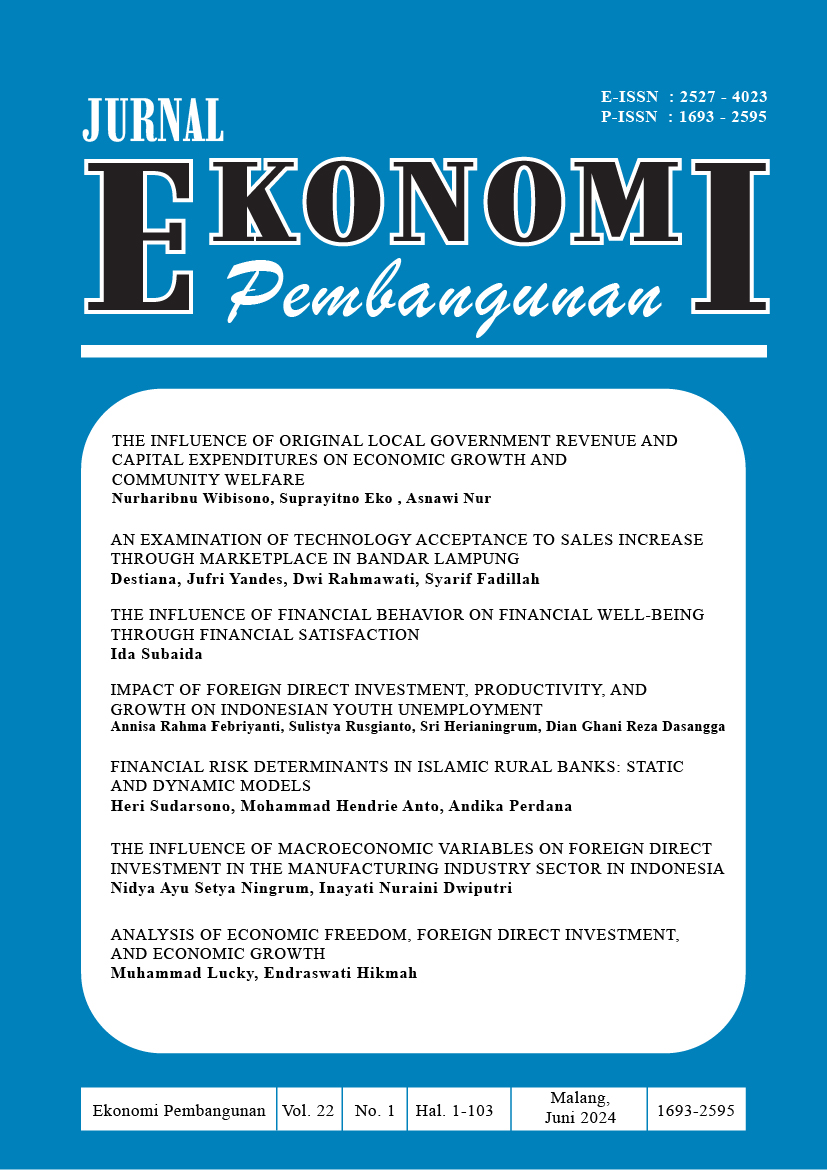Analysis of Economic Freedom, Foreign Direct Investment, and Economic Growth
DOI:
https://doi.org/10.22219/jep.v22i01.33754Keywords:
Economic Growth, Foreign Direct Investment, Economic Freedom, VECM, Granger CausalityAbstract
This research analyzes the relationship between economic freedom, foreign direct investment (FDI), and economic growth using the Vector Error Correction (VECM) model and the Granger causality test. Panel data from several free trade agreement countries in the Regional Comprehensive Economic Partnership (RPEC) for 1997 – 2022. VECM captures cointegration relationships and models short-term adjustments toward long-term balance. Meanwhile, the Granger causality test helps identify the direction of the causal relationship between economic freedom, FDI, and economic growth. Empirical results show a long-term but weak cointegration relationship between these variables in the short term. In addition, it was found that there is a two-way causality between economic freedom and economic growth, as well as between FDI and economic growth. These findings imply that policies encouraging economic freedom and attracting foreign investment can increase a country's economic growth. This research provides empirical insights into the important role of economic freedom and FDI in driving economic growth and related policy implications for creating an environment conducive to investment and sustainable economic growth.
Downloads
References
Afdal Mubarak, M., & Endraswati, H. (2023). Investigating the Impact of FDI , Foreign Aid , and Islamic Capital Markets on Carbon Emission in ASEAN : The Moderating Role of Regulatory Quality. Journal of Economics Development Issues, 6(2), 60–74.
Alfar, A. J. K., Elheddad, M., & Doytch, N. (2024). Impact of political conflict on foreign direct investments in the mining sector: Evidence from the event study and spatial estimation. Journal of Environmental Management, 350(October 2023), 119590. https://doi.org/10.1016/j.jenvman.2023.119590
Alfaro, L., Chanda, A., Kalemli-Ozcan, S., & Sayek, S. (2010). Does foreign direct investment promote growth? Exploring the role of financial markets on linkages. Journal of Development Economics, 91(2), 242–256. https://doi.org/10.1016/j.jdeveco.2009.09.004
Bilas, V. (2020). FDI AND ECONOMIC GROWTH IN EU13 COUNTRIES : COINTEGRATION AND CAUSALITY TESTS. 12, 47–63.
Breusch, T. S., & Pagan, A. R. (1980). The Lagrange Multiplier Test and its Applications to Model Specification in Econometrics. Review of Economic Studies, 47(1), 239–253.
Chan, M. W. L., Hou, K., Li, X., & Mountain, D. C. (2014). Foreign direct investment and its determinants: A regional panel causality analysis. Quarterly Review of Economics and Finance, 54(4), 579–589. https://doi.org/10.1016/j.qref.2013.07.004
Chanegriha, M., Stewart, C., Tsoukis, C., & Chanegriha, M. (2020). Testing for causality between FDI and economic growth using heterogeneous panel data using heterogeneous panel data. The Journal of International Trade &Economic Development, 0(0), 1–20. https://doi.org/10.1080/09638199.2019.1704843
Ciftci, C., & Durusu-Ciftci, D. (2022). Economic freedom, foreign direct investment, and economic growth: The role of sub-components of freedom. Journal of International Trade and Economic Development, 31(2), 233–254. https://doi.org/10.1080/09638199.2021.1962392
Dunning, J. H. (1988). The Eclectic Paradigm of International Production: A Restatement and Some Possible Extensions. Journal of International Business Studies, 19(1), 1–31. https://doi.org/10.1057/palgrave.jibs.8490372
Hayel, N. M., & Saiydy, B. E. (2021). The Impact of Foreign Direct Investment (FDI) on Economic Growth (EG): Evidence from Djibouti. International Research in Education, 9(2), 64. https://doi.org/10.5296/ire.v9i2.19134
Heckelman, J. C. (2019). Economic Freedom and Economic Growth : A Short- Run Causal Investigation. 0326. https://doi.org/10.1080/15140326.2000.12040546
Hermes, N., & Lensink, R. (2003). The Journal of Development Studies Foreign direct investment, financial development and economic growth Foreign Direct Investment, Financial Development and Economic Growth. The Journal of Development Studies, 40(1), 142–163.
North, D. C. (1989). Institutions and economic growth: An historical introduction. World Development, 17(9), 1319–1332. https://doi.org/10.1016/0305-750X(89)90075-2
Ofori, I. K., Figari, F., & Ojong, N. (2023). Towards sustainability: The relationship between foreign direct investment, economic freedom and inclusive green growth. Journal of Cleaner Production, 406(March), 137020. https://doi.org/10.1016/j.jclepro.2023.137020
Pesaran, M. H., Ullah, A., & Yamagata, T. (2008). A bias-adjusted LM test of error cross-section independence. Econometrics Journal, 11(1), 105–127. https://doi.org/10.1111/j.1368-423X.2007.00227.x
Setyono, F., Prihatiningtyas, D., & Wibowo, M. G. (2023). Pengaruh Utang Luar Negeri dan Foreign Direct Investment Terhadap Pertumbuhan Ekonomi Organisasi Konferensi Islam. Jurnal Orientasi Bisnis Dan Entrepreneurship (JOBS), 4(1), 45–56. https://doi.org/10.33476/jobs.v4i1.3619
Singh, D., & Gal, Z. (2020). Economic Freedom and its Impact on Foreign Direct Investment: Global Overview. Review of Economic Perspectives, 20(1), 73–90. https://doi.org/10.2478/revecp-2020-0004
Tanna, S., & Topaiboul, K. (2014). Human Capital , Trade , FDI and Economic Growth in Thailand : What causes What ? May 2005.
Tanoe, V. (2021). Analysis of Net Trade, FDI and GDP Growth Using Cointegration, Vecm, Granger Causality and a Regression Approach: A Case Study of Sub Saharan African Region. SSRN Electronic Journal, January 2020. https://doi.org/10.2139/ssrn.3728332
Vega-gordillo, M. (2014). Economic Growth and Freedom : A Causality Study. December.
Downloads
Published
Issue
Section
License
Copyright (c) 2024 muhammad lucky lucky, Endraswati Hikmah

This work is licensed under a Creative Commons Attribution-NonCommercial-ShareAlike 4.0 International License.
Authors who publish with Jurnal Ekonomi Pembangunan (JEP) agree to the following terms:
- For all articles published in Jurnal Ekonomi Pembangunan (JEP), copyright is retained by the authors. Authors permit the publisher to announce the work with conditions. When the manuscript is accepted for publication, the authors agree to the publishing right's automatic transfer to the publisher.
- Authors retain copyright and grant the journal right of first publication with the work simultaneously licensed under a Creative Commons Attribution-NonCommercial-ShareAlike 4.0 International License that allows others to share the work with an acknowledgment of the work's authorship and initial publication in this journal.
- Authors can enter into separate, additional contractual arrangements for the non-exclusive distribution of the journal's published version of the work (e.g., post it to an institutional repository or publish it in a book), with an acknowledgment of its initial publication in this journal.
- Authors are permitted and encouraged to post their work online (e.g., in institutional repositories or on their website) before and during the submission process, as it can lead to productive exchanges and earlier and greater citation of published work (See The Effect of Open Access).

This work is licensed under a Creative Commons Attribution-NonCommercial-ShareAlike 4.0 International License.






















